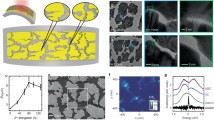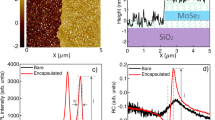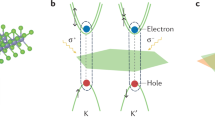Abstract
Monolayer transition metal dichalcogenides (TMDCs) have recently been proposed as an excitonic platform for advanced optical and electronic functionalities1,2,3. However, in spite of intense research efforts, it has not been widely appreciated that TMDCs also possess a high refractive index4,5. This characteristic opens up the possibility to utilize them to construct resonant nanoantennas based on subwavelength geometrical modes6,7. Here, we show that nanodisks, fabricated from exfoliated multilayer WS2, support distinct Mie resonances and anapole states8 that can be tuned in wavelength over the visible and near-infrared range by varying the nanodisk size and aspect ratio. As a proof of concept, we demonstrate a novel regime of light–matter interaction—anapole-exciton polaritons—which we realize within a single WS2 nanodisk. We argue that the TMDC material anisotropy and the presence of excitons enrich traditional nanophotonics approaches based on conventional high-index materials and/or plasmonics.
This is a preview of subscription content, access via your institution
Access options
Access Nature and 54 other Nature Portfolio journals
Get Nature+, our best-value online-access subscription
$29.99 / 30 days
cancel any time
Subscribe to this journal
Receive 12 print issues and online access
$259.00 per year
only $21.58 per issue
Buy this article
- Purchase on Springer Link
- Instant access to full article PDF
Prices may be subject to local taxes which are calculated during checkout



Similar content being viewed by others
Data availability
The data plotted in Figs. 1a–c,d, 2b–e and 3a–f can be accessed via Figshare repository via the link https://figshare.com/s/4b8abbb708335aee3cc5
References
Mak, K. F., Lee, C., Hone, J., Shan, J. & Heinz, T. F. Atomically thin MoS2: a new direct-gap semiconductor. Phys. Rev. Lett. 105, 136805 (2010).
Chernikov, A. et al. Exciton binding energy and nonhydrogenic Rydberg series in monolayer WS2. Phys. Rev. Lett. 113, 076802 (2014).
Mak, K. F. & Shan, J. Photonics and optoelectronics of 2D semiconductor transition metal dichalcogenides. Nat. Photon. 10, 216–226 (2016).
Wilson, J. A. & Yoffe, A. D. The transition metal dichalcogenides discussion and interpretation of the observed optical, electrical and structural properties. Adv. Phys. 18, 193–335 (1969).
Hu, F. et al. Imaging exciton–polariton transport in MoSe2 waveguides. Nat. Photon. 11, 356–360 (2017).
Kuznetsov, A. I., Miroshnichenko, A. E., Brongersma, M. L., Kivshar, Y. S. & Lukyanchuk, B. Optically resonant dielectric nanostructures. Science 354, aag2472 (2016).
Staude, I. & Schilling, J. Metamaterial-inspired silicon nanophotonics. Nat. Photon. 11, 274–284 (2017).
Miroshnichenko, A. E. et al. Nonradiating anapole modes in dielectric nanoparticles. Nat. Commun. 6, 8069 (2015).
Geim, A. K. & Grigorieva, I. V. Van der Waals heterostructures. Nature 499, 419–425 (2013).
Kleemann, M.-E. et al. Strong-coupling of WSe2 in ultra-compact plasmonic nanocavities at room temperature. Nat. Commun. 8, 1296 (2017).
Stührenberg, M. et al. Strong light–matter coupling between plasmons in individual gold bi-pyramids and excitons in mono- and multilayer WSe2. Nano Lett. 18, 5938–5945 (2018).
Liang, W. Y. Optical anisotropy in layer compounds. J. Phys. C 6, 551 (1973).
Li, Y. et al. Measurement of the optical dielectric function of monolayer transition-metal dichalcogenides: MoS2, MoSe2, WS2, and WSe2. Phys. Rev. B 90, 205422 (2014).
Zenin, V. A. et al. Direct amplitude-phase near-field observation of higher-order anapole states. Nano Lett. 17, 7152–7159 (2017).
Savinov, V., Fedotov, V. A. & Zheludev, N. I. Toroidal dipolar excitation and macroscopic electromagnetic properties of metamaterials. Phys. Rev. B 89, 205112 (2014).
Papasimakis, N., Fedotov, V. A., Savinov, V., Raybould, T. A. & Zheludev, N. I. Electromagnetic toroidal excitations in matter and free space. Nat. Mater. 15, 263–271 (2016).
Powell, D. A. Interference between the modes of an all-dielectric meta-atom. Phys. Rev. Appl. 7, 034006 (2017).
Zhang, S., Genov, D. A., Wang, Y., Liu, M. & Zhang, X. Plasmon-induced transparency in metamaterials. Phys. Rev. Lett. 101, 047401 (2008).
Hsu, C. W., DeLacy, B. G., Johnson, S. G., Joannopoulos, J. D. & Soljačić, M. Theoretical criteria for scattering dark states in nanostructured particles. Nano Lett. 14, 2783–2788 (2014).
Bohren, C. F. & Huffman, D. R. Absorption and Scattering of Light by Small Particles (Wiley, 1998).
Törmä, P. & Barnes, W. L. Strong coupling between surface plasmon polaritons and emitters: a review. Rep. Prog. Phys. 78, 013901 (2015).
Baranov, D. G., Wersall, M., Cuadra, J., Antosiewicz, T. J. & Shegai, T. Novel nanostructures and materials for strong light–matter interactions. ACS Photon. 5, 24–42 (2017).
Antosiewicz, T. J., Apell, S. P. & Shegai, T. Plasmon–exciton interactions in a core–shell geometry: from enhanced absorption to strong coupling. ACS Photon. 1, 454–463 (2014).
Haus, H. A. Waves and Fields in Optoelectronics (Prentice-Hall, 1983).
Chikkaraddy, R. et al. Single-molecule strong coupling at room temperature in plasmonic nanocavities. Nature 535, 127–130 (2016).
Santhosh, K., Bitton, O., Chuntonov, L. & Haran, G. Vacuum Rabi splitting in a plasmonic cavity at the single quantum emitter limit. Nat. Commun. 7, 11823 (2016).
Wang, H. et al. Resonance coupling in silicon nanosphere–J-aggregate heterostructures. Nano Lett. 16, 6886–6895 (2016).
Lepeshov, S. et al. Tunable resonance coupling in single Si nanoparticle–monolayer WS2 structures. ACS Appl. Mater. Interfaces 10, 16690–16697 (2018).
Liu, S.-D., Fan, J.-L., Wang, W.-J., Chen, J.-D. & Chen, Z.-H. Resonance coupling between molecular excitons and nonradiating anapole modes in silicon nanodisk–J-aggregate heterostructures. ACS Photon. 5, 1628–1639 (2018).
Tiguntseva, E. Y. et al. Tunable hybrid Fano resonances in halide perovskite nanoparticles. Nano Lett. 18, 5522–5529 (2018).
Yadgarov, L. et al. Strong light–matter interaction in tungsten disulfide nanotubes. Phys. Chem. Chem. Phys. 20, 20812–20820 (2018).
Munkhbat, B. et al. Self-hybridized exciton-polaritons in multilayers of transition metal dichalcogenides for efficient light absorption. ACS Photon. 6, 139–147 (2019).
Kim, S. et al. Photonic crystal cavities from hexagonal boron nitride. Nat. Commun. 9, 2623 (2018).
Andres, C.-G. et al. Deterministic transfer of two-dimensional materials by all-dry viscoelastic stamping. 2D Mater. 1, 011002 (2014).
Acknowledgements
The authors acknowledge financial support from the Olle Engkvist Foundation, the Knut and Alice Wallenberg Foundation, Chalmers Excellence Initiative Nano and the Swedish Research Council (Vetenskapsrådet).
Author information
Authors and Affiliations
Contributions
D.B., R.V., M.K. and T.S. conceived the project, R.V. designed the experiment and fabricated the samples, D.B. developed the theoretical models and performed the simulations, B.M. and J.C. measured the optical response. All authors contributed to analysis of the results and writing the manuscript.
Corresponding authors
Ethics declarations
Competing interests
The authors declare no competing interests.
Additional information
Journal peer review information: Nature Nanotechnology thanks Andrea Alu and other anonymous reviewer(s) for their contribution to the peer review of this work.
Publisher’s note: Springer Nature remains neutral with regard to jurisdictional claims in published maps and institutional affiliations.
Supplementary Information
Supplementary Information
Supplementary Figs. 1–8
Rights and permissions
About this article
Cite this article
Verre, R., Baranov, D.G., Munkhbat, B. et al. Transition metal dichalcogenide nanodisks as high-index dielectric Mie nanoresonators. Nat. Nanotechnol. 14, 679–683 (2019). https://doi.org/10.1038/s41565-019-0442-x
Received:
Accepted:
Published:
Issue Date:
DOI: https://doi.org/10.1038/s41565-019-0442-x
This article is cited by
-
Ultra-compact exciton polariton modulator based on van der Waals semiconductors
Nature Communications (2024)
-
Probing optical anapoles with fast electron beams
Nature Communications (2023)
-
Intrinsic strong light-matter coupling with self-hybridized bound states in the continuum in van der Waals metasurfaces
Nature Materials (2023)
-
Applications of bound states in the continuum in photonics
Nature Reviews Physics (2023)
-
A novel spectroscopic technique for studying metal–organic frameworks based on Mie scattering
Analytical and Bioanalytical Chemistry (2023)



